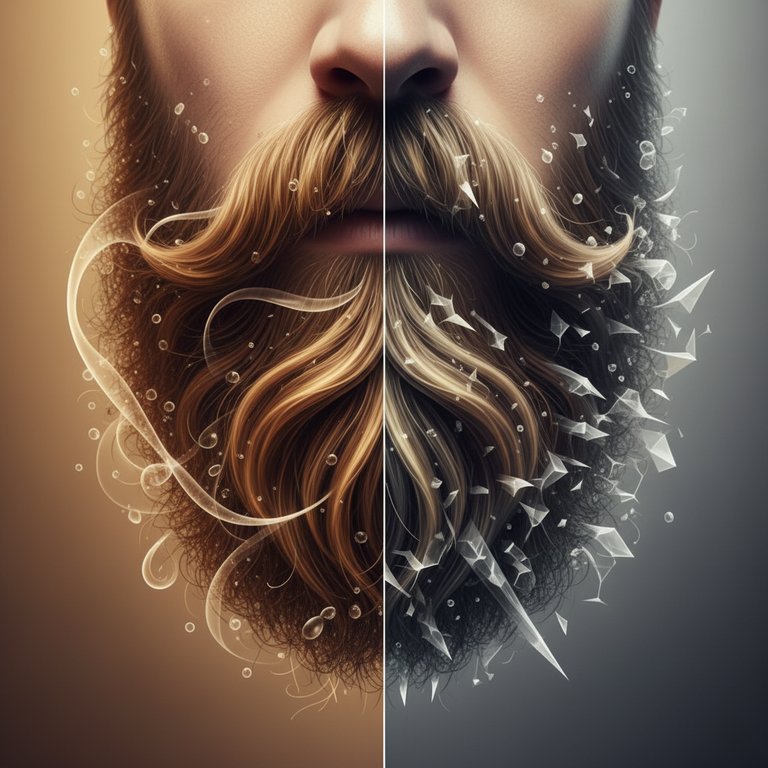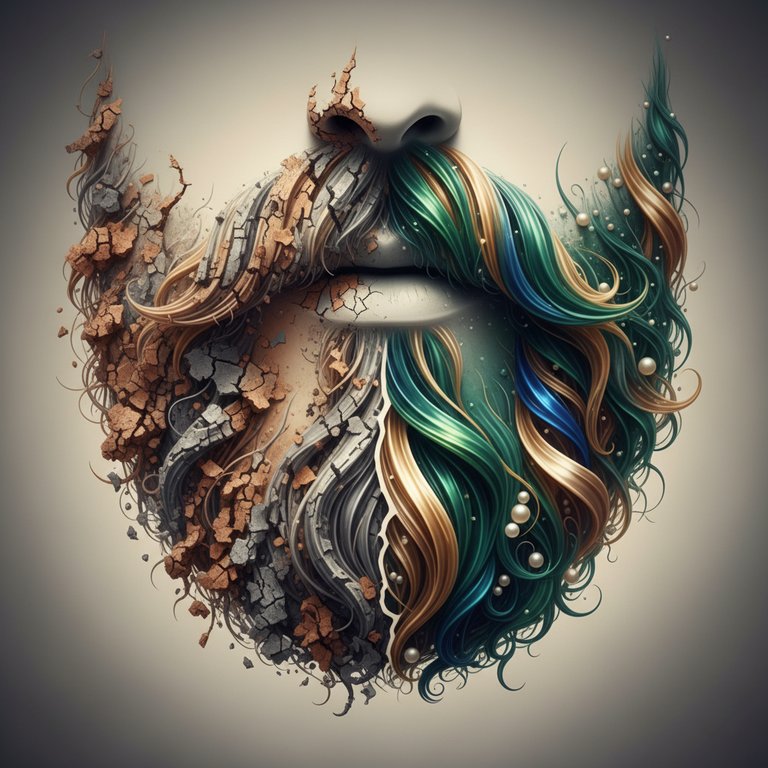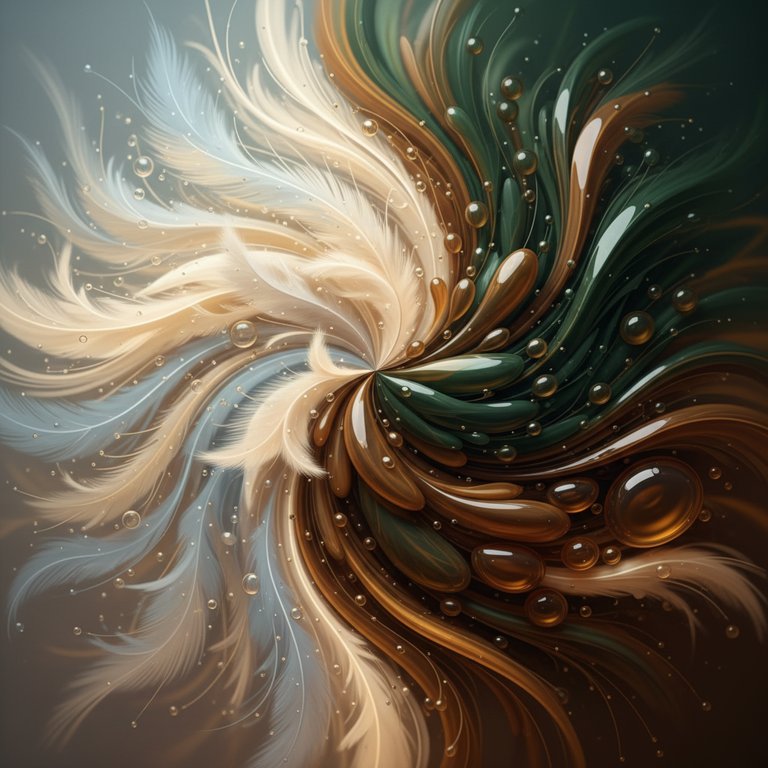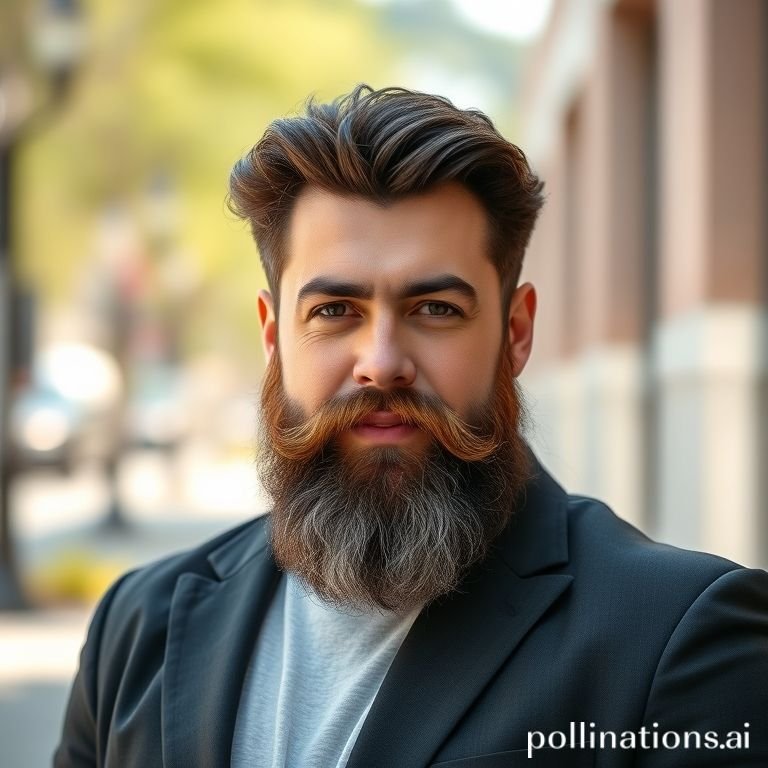Hey there, fellow beard enthusiasts! Ever found yourself in a bit of a styling bind? Maybe you’re out of your favorite beard balm, or you’re trying to achieve that perfect, unbudgeable hold for a special occasion. And then, your eyes land on it: that trusty can of hairspray sitting on the shelf. A quick thought flashes through your mind – “It’s for hair, right? My beard is hair… so, could it work?”
It’s a tempting thought, I get it. We’ve all been there, looking for a quick fix or an alternative when our usual grooming arsenal is depleted. But before you unleash that misty cloud of hold onto your glorious facial hair, let’s hit the brakes for a second. We need to talk about whether reaching for hairspray is a brilliant hack or a recipe for beard disaster. Spoiler alert: it’s usually the latter. Let’s dive deep into why this common household item isn’t your beard’s best friend and what you should be using instead to keep your mane looking magnificent.
The Allure (and Peril) of Hairspray for Beards
So, why does the idea of using hairspray on a beard even cross our minds? Simple: it promises hold. We see it keeping head hair perfectly in place, defying gravity and humidity. For those stubborn beard hairs that refuse to cooperate, or when you want a really neat, sculpted look, hairspray seems like a logical, readily available solution. It’s cheap, it’s everywhere, and it’s designed for hair – what could go wrong?
Well, quite a bit, actually. While chemically, head hair and beard hair share similarities, their environment and typical care routines are vastly different. Your beard hair tends to be coarser, thicker, and often curlier than the hair on your head. Plus, it’s growing right on your face, close to sensitive skin that needs to breathe and stay moisturized. Hairspray, designed primarily for the scalp and head hair, doesn’t take these unique beard factors into account, and that’s where the trouble begins.
What's Really in Your Hairspray? (And Why It Matters for Your Beard)
Let’s get a little bit scientific, but in a totally casual, friendly way. Most traditional hairsprays are packed with a few key ingredients that are great for head hair but can be problematic for your beard. Think of them as a team working together to give you that stiff, unmoving hold:
- Alcohols: Many hairsprays contain high levels of alcohol (like ethanol or isopropyl alcohol). While these help the product dry quickly and provide that instant hold, they are notorious for stripping natural oils. Your beard, and the skin beneath it, relies on these natural oils to stay soft, hydrated, and healthy. Regular exposure to alcohol can leave your beard feeling dry, brittle, and looking dull.
- Polymers: These are the magic ingredients that create a flexible film around each strand of hair, literally holding it in place. While effective, these polymers can build up over time, especially on beard hair which isn't washed as vigorously or frequently as head hair. This buildup can make your beard feel crunchy, sticky, and can even clog pores on your face.
- Propellants and Fragrances: The stuff that makes the spray come out of the can, and the scents that make it smell nice (or sometimes, not so nice). These can be irritating to the sensitive skin on your face, potentially leading to discomfort.
Compare this to dedicated beard products like beard oil or balm. These are formulated with natural carrier oils (like jojoba, argan, almond) and essential oils that nourish both the hair and the skin. They're designed to condition and protect, not just hold. See the difference? It’s like trying to use engine oil in your cooking – both are oils, but they have very different purposes and ingredients!
The Damage Report: What Could Go Wrong?
Okay, so we’ve peeked under the hood of hairspray. Now, let’s talk about the real-world consequences of using it on your beard. It’s not just about a bad hair day; it can genuinely impact the look and feel of your facial hair over time.
Dryness and Brittleness
As mentioned, the high alcohol content in hairspray is a natural oil stripper. Your beard needs its natural oils to stay moisturized and pliable. Without them, your beard hairs become dry, rough, and much more prone to breakage. Imagine your beard becoming less like a soft cloud and more like a bundle of straw – not exactly the look we’re going for!
Residue Buildup
Those polymers that give you hold? They don’t just magically disappear. They accumulate. Over time, hairspray residue can build up on your beard hairs, making them feel stiff, sticky, and even look dull or dusty. This can also make your beard harder to comb and manage, and it simply won't feel pleasant to touch.
Unpleasant Texture
A soft, touchable beard is a happy beard. Hairspray, however, tends to make hair feel crunchy, stiff, and unnatural. This might be okay for a super-styled updo on your head, but for your beard, which is constantly exposed and often touched, it’s just not comfortable or appealing.
Styling Limitations
While hairspray offers a strong hold, it’s often an inflexible hold. Beard hairs, especially longer ones, need a bit of natural movement to look their best. Hairspray can make your beard look unnaturally rigid, losing that natural flow and texture that makes a beard look truly great. It also doesn't allow for easy restyling throughout the day.
The Right Tools for the Job: Beard-Specific Styling
So, if hairspray is out, what’s in? The good news is that the world of beard grooming has evolved, and there are fantastic products specifically designed to give your beard the hold, shape, and nourishment it needs without any of the downsides of hairspray.
- Beard Balm: This is your everyday hero. A good beard balm offers a light to medium hold, helps to tame flyaways, and conditions your beard with natural oils and butters. It’s perfect for shaping, adding a bit of volume, and keeping your beard looking neat and healthy.
- Beard Wax: For those days when you need serious hold, beard wax steps up. It’s thicker and has a stronger grip than balm, ideal for shaping a handlebar mustache or keeping a particularly wild beard in line. Just remember, a little goes a long way!
- Beard Oil: While not a styling product in itself, beard oil is fundamental for a healthy, manageable beard. It moisturizes the hair and the skin underneath, making your beard softer, reducing itchiness, and preparing it for styling. Think of it as the primer before you paint!
These products are formulated to work with your beard’s natural texture and needs, providing hold while also delivering beneficial ingredients that keep your facial hair looking and feeling its best.
My Go-To Beard Styling Routine (No Hairspray Needed!) - Step-by-Step
Want to achieve a perfectly styled beard that feels great and looks even better? Here’s my personal routine, designed to keep your beard healthy and handsome without ever touching a can of hairspray:
Step 1: Cleanse (Gently!)
Start with a clean slate. Wash your beard 2-3 times a week (or as needed, depending on your lifestyle and beard length) with a dedicated beard wash. These are milder than regular shampoos and won't strip your beard of its essential oils. Pat it gently with a towel until it's damp, not dripping wet.
Step 2: Condition & Hydrate
While your beard is still slightly damp, apply a few drops of high-quality beard oil. Rub it between your palms and work it thoroughly into your beard, making sure to reach the skin underneath. This step is crucial for hydration and softness. For longer beards, you might follow up with a leave-in beard conditioner for extra softness.
Step 3: Detangle & Shape
Once the oil is absorbed, use a wide-tooth beard comb or a good quality beard brush (boar bristle is excellent!) to detangle your beard and start guiding the hairs into your desired shape. Combing distributes the oil evenly and helps to train your beard hairs to grow in a particular direction.
Step 4: Lock in the Style
Now for the hold! Scoop out a small amount of beard balm (for light to medium hold) or beard wax (for stronger hold) with your thumbnail. Emulsify it by rubbing it between your palms until it's warm and pliable. Then, apply it evenly throughout your beard, working from the roots to the tips. Use your fingers to shape and sculpt your beard into place.
Step 5: Finish Strong
For a polished finish, give your beard one last brush or comb-through to smooth everything down and ensure all hairs are sitting perfectly. You can use a blow dryer on a cool setting with a brush to further refine the shape, but always remember to keep the heat low to avoid drying out your beard.
Pro Tips for a Magnificent Mane (Without the Hairspray)
Beyond the routine, here are a few extra nuggets of wisdom to help you achieve beard greatness:
- Invest in Quality Tools: A good beard comb, a boar bristle brush, and sharp trimming scissors make all the difference.
- Consistency is Key: Stick to your grooming routine. Your beard will thank you for it by becoming more manageable and healthier over time.
- Don't Overdo Products: Start with a small amount of balm or wax and add more if needed. Too much can make your beard greasy or heavy.
- Listen to Your Beard: Pay attention to how your beard feels. If it seems dry, add a bit more oil. If it’s getting unruly, trim it or use a stronger hold product.
- Trim Regularly: Even if you’re growing it out, regular micro-trims (every few weeks) help remove split ends and maintain a neat shape.
Frequently Asked Questions About Beard Care & Styling
Let's tackle some common questions that pop up in the beard community!
How can I make my beard look thicker and fuller?
Achieving a thicker, fuller look involves a combination of patience and proper grooming. Firstly, let it grow! Don’t trim too aggressively in the early stages. Regular use of beard oil helps condition the individual hairs, making them appear healthier and less prone to breakage, which can contribute to a fuller appearance. Using a beard balm with a light hold can also help to fluff up and style your beard, giving the illusion of more volume. Brushing your beard upwards and then styling it down can add significant body. Also, making sure your beard is clean and free of product buildup allows each hair to stand on its own, contributing to overall fullness.
What's the difference between beard balm and beard wax?
Great question! Both are styling products, but they offer different levels of hold and benefits. Beard balm is generally softer and creamier, offering a light to medium hold. Its primary purpose is to condition, moisturize, and lightly style your beard, taming flyaways and adding a healthy sheen. It’s often packed with natural butters and oils. Beard wax, on the other hand, is much firmer and provides a stronger, more rigid hold. It’s designed for more precise styling, like shaping a mustache or keeping a very long or unruly beard perfectly in place. Think of balm for daily conditioning and light styling, and wax for when you need serious, long-lasting control.
How often should I wash my beard?
This really depends on your lifestyle, skin type, and how much product you use. Generally, washing your beard 2-3 times a week with a dedicated beard wash is a good starting point. Washing too frequently with harsh products can strip your beard of its natural oils, leading to dryness. If you work in a dirty environment, exercise a lot, or use heavy styling products daily, you might need to wash more often. On days you don't wash, you can simply rinse your beard with water and apply beard oil to refresh it.
Can I use regular hair conditioner on my beard?
While it might seem like a convenient substitute, it's generally best to stick to beard-specific conditioners or leave-in beard balms. Regular hair conditioners are formulated for the hair on your head, which often has different needs than your coarser facial hair. More importantly, they might contain ingredients that aren't ideal for the sensitive skin on your face, potentially leading to irritation or residue buildup. Beard conditioners are designed to soften facial hair and nourish the skin underneath without causing issues.
Why does my beard feel dry even after using oil?
If your beard still feels dry after applying oil, there could be a few reasons. First, ensure you're using enough oil – longer, thicker beards need more. Second, check the quality of your beard oil; some cheaper oils might not be as effective. Third, make sure you're applying it correctly – work it down to the skin, not just on the surface hairs. Your environment (dry air, wind) can also play a role, as can how often you wash your beard (too much washing can strip oils). Consider adding a beard balm to your routine, as its heavier butters can provide an extra layer of moisture and protection, especially if you live in a dry climate.
How do I tame flyaways and frizz in my beard?
Flyaways and frizz are common, but totally fixable! The key is hydration and proper styling. Start with a good beard oil to moisturize the hair, making it softer and less prone to frizz. Follow up with a beard balm, which provides a light hold and helps to lay down those unruly hairs. Using a quality boar bristle brush is also a game-changer; it helps distribute products evenly and smooths the hair cuticle, reducing frizz. For stubborn areas, a tiny bit of beard wax can provide extra control. Regular trims to remove split ends also contribute to a smoother, neater appearance.
Conclusion
So, to answer the burning question: Does using hairspray on my beard damage it? While a single, accidental spritz probably won't be the end of the world, consistent use can absolutely lead to dryness, brittleness, residue buildup, and an overall unhappy beard. It’s simply not designed for the unique needs of your facial hair or the sensitive skin beneath it.
Embrace the wonderful world of dedicated beard grooming products! With a little beard oil, balm, and the right tools, you can achieve a perfectly styled, healthy, and touchable beard that looks fantastic without resorting to quick fixes that do more harm than good. Your beard deserves the best, so treat it right!
Disclaimer: This blog post is for informational purposes only and is not intended to provide professional advice. Always use products as directed and consider what works best for your individual beard and skin.



